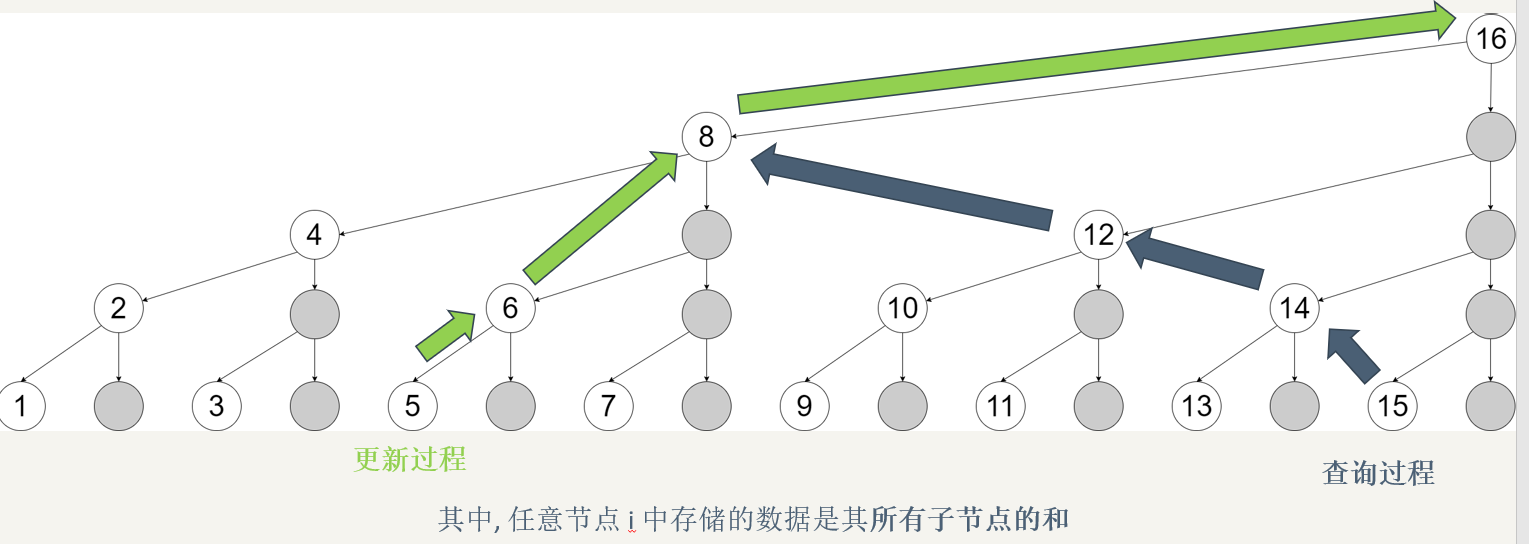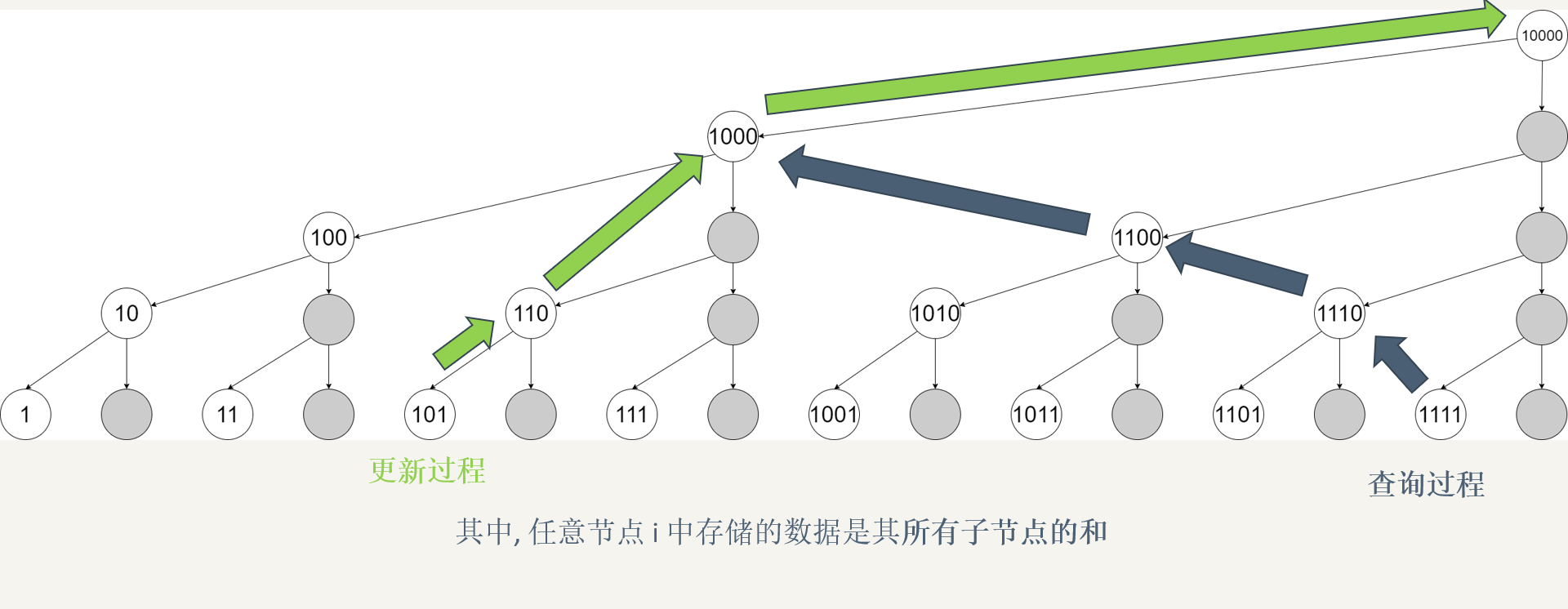Some content sources: bestsort blog
Recommended blog:
CSDN: Nangong Yichen - thoroughly understand the two-dimensional tree array
CSDN: Lv1_kangdi - 2D tree array summary and template
The one-dimensional tree array sum[x] records the prefix and length of lowbit(x) from 1 to X
The two-dimensional tree array sum [x] [y] records the sum of areas from [1,1] to [x,y], with the height of lowbit(y) and the length of lowbit(x)
Example: Tree array - related template questions
One dimensional tree array
Illustration:

- Binary representation

lowbit() function
lowbit(x) represents the value corresponding to the lowest 1 in the binary expression of X
int lowbit(int x){
return x & (-x);
}
Single point modification
- Update from bottom to top to update the interval containing the point
- For example, when updating [5], the update order is sum [5], sum [6], sum [8], sum [16] (n < = 16)
- Binary representation is sum[101], sum[110], sum[1000], sum[10000]
- The upward update point is the current number + the value of the binary lowest 1 of the number (x + lowbit(x))
void updata(int id,int x,int n){
while(id <= n){
sum[id] += x;
id += lowbit(id);
}
}
Interval query
- Query interval prefix and from bottom to top
- When querying, it is the sum of the current query number interval + the previous interval
- For example, when querying [1,13] intervals, the query intervals are sum[13], sum[12], sum[8] (sum[13] is the sum of [13,13], sum[12] is the sum of [9,12], and sum[8] is the sum of [1,8])
- Expressed in binary: sum[1101] + sum[1100] + sum[1000]
- The point queried upward is the current number - the value of the lowest binary 1 of the number (x - lowbit(x))
- The array sum[x] records the interval prefix sum of (x-lowbit (x), x)] (note that it is opened before closed)
int query(int id){
int res = 0 ;
while(id){
res += sum[id];
id -= lowbit(id);
}
return res;
}
Interval modification + single point query
Difference: a[i] is the original array, and the b[i] array is constructed so that b[i] = a[i] - a[i-1], that is, a[i] = a[i-1] + b[i] -- > a[i] is the prefix and sum of b[i]

Interval modification:
The interval modification of a[i] is transformed into a single point modification of b[i] by difference: a [l, R] + X -- > b [l] + X, B [R + 1] - X
Single point query:
It is also an interval query that uses difference to convert it into b[i]: a [i] -- > b [1, R]
int a[N],b[N]; // a [] original array, b [] differential array
int lowbit(int id){
return id & -id;
}
//Single point query
int query(int id){
int res = 0;
while(id) res += id, id -= lowbit(id);
return res;
}
// Single point modification of differential array
void alter(int id,int x,int n){
while(id <= n) b[id] += x, id += lowbit(id);
}
//Interval modification
int update(int l,int r,int x,int n) {
alter(l,x,n),alter(r+1,-x,n);
}
Interval modification + interval query
Similarly, use difference to build two arrays (explain the reasons below):
sum1[i] = b[i]
sum2[i] = b[i] * i
The principle of interval modification is basically the same as above: a [l, R] X -- > sum1 [l] + X, sum2 [R + 1] - X
Interval query: Sum_ a[l,r] --> (p+1) * sum1[i] - sum2[i] - ( (p+1) * sum1 - sum2[i] )
a[i] is the prefix sum of b[i], and the prefix sum of a[i] is the double prefix sum of b[i], as shown in the figure:

a[i] = b[i] + b[i-1] + b[i-2] +... + b[1]
a[1] = b[1]
a[2] = b[1] + b[2]
a[3] = b[1] + b[2] + b[3]
a[4] = b[1] + b[2] + b[3] +b[4]
In the prefix sum of a[p], b[1] uses p times, b[2] uses p-1 times, and so on (equation 3 above):
sum_a[p] = p * b[1] + (p-1) * b[2] + (p-3) * b[3] + ...+2 * b[p-1]+ 1 * b[p]
sum_a[p] = (p-i+1) * b[i] = (p+1) * b[i] - i * b[i]
Therefore, two formulas are used to maintain interval queries:
sum1[i] = b[i]
sum2[i] = b[i] * i
Note: when maintaining sum2 array, sum2[i] += id*x
int sum1[N], sum2[N];
//Point modification in interval modification
void alter(int id, int x, int n){
int i = id;
while(i <= n) sum1[i] += x, sum2[i] += id*x , i += lowbit(i);
}
// Interval modification
void update(int l,int r, int x, int n){
alter(l, x, n), alter(r+1, -x, n);
}
// Point query in interval query
int query(int id){
int res = 0, i = id;
while(i){
res += (id+1) * sum1[i] - sum2[i], i -= lowbit(i);
}
return res;
}
// Interval query
int range_query(int l,int r){
return query(l) - query(r-1);
}
Two dimensional tree array
Recommended blog: 2D tree array summary and template:
Interval query + single point modification
int s[N][N], n ;
int lowbit(int x){
return x & -x;
}
// Single point modification
void updata(int x, int y, int d){
while(x <= n){
int yy = y;
while(yy <= n)
s[x][yy] += d, yy += lowbit(yy);
x += lowbit(x);
}
}
// Interval query
int query(int x, int y){
int res = 0;
while(x){
int yy = y;
while(yy) res += s[x][yy], yy -= lowbit(yy);
x -= lowbit(x);
}
}
Interval modification + single point query
/**two-dimensional
* Interval modification + single point query
* **/
int a[N][N], b[N][N];
void updata(int x,int y, int d){
while(x <= n){
int yy = y;
while(yy <= n)
b[x][yy] += d, yy += lowbit(yy);
x += lowbit(x);
}
}
// modify
void range_updata(int x1,int y1,int x2,int y2, int d){
updata(x1, y1, d);
updata(x1+1, y2, -d);
updata(x2, y1+1, -d);
updata(x2+1, y2+1, d);
}
// query
int query(int x, int y){
int res = 0;
while(x){
int yy = y;
while(yy) res += b[x][yy], yy -= lowbit(yy);
x -= lowbit(x);
}
}
Interval modification + interval query
On the two-dimensional prefix and sum of points (x,y)
∑ i = 1 x ∑ j = 1 y ∑ k = 1 i ∑ h = 1 j d [ h ] [ k ] \sum_{i=1}^{x}\sum_{j=1}^{y}\sum_{k=1}^{i}\sum_{h=1}^{j}d[h][k] i=1∑xj=1∑yk=1∑ih=1∑jd[h][k]
∑ i = 1 x ∑ j = 1 y d [ i ] [ j ] ∗ ( x + 1 − i ) ∗ ( y + 1 − j ) \sum_{i=1}^{x}\sum_{j=1}^{y}d[i][j] * (x+1-i) * (y+1-j) i=1∑xj=1∑yd[i][j]∗(x+1−i)∗(y+1−j)
( x + 1 ) ∗ ( y + 1 ) ∗ ∑ i = 1 x ∑ j = 1 y d [ i ] [ j ] − ( y + 1 ) ∗ ∑ i = 1 x ∑ j = 1 y d [ i ] [ j ] ∗ i − ( x + 1 ) ∗ ∑ i = 1 x ∑ j = 1 y d [ i ] [ j ] ∗ j + ∑ i = 1 x ∑ j = 1 y d [ i ] [ j ] ∗ i ∗ j (x+1)*(y+1)*\sum_{i=1}^{x}\sum_{j=1}^{y}d[i][j]-(y+1)*\sum_{i=1}^{x}\sum_{j=1}^{y}d[i][j]*i-(x+1)*\sum_{i=1}^{x}\sum_{j=1}^{y}d[i][j]*j+\sum_{i=1}^{x}\sum_{j=1}^{y}d[i][j]*i*j (x+1)∗(y+1)∗i=1∑xj=1∑yd[i][j]−(y+1)∗i=1∑xj=1∑yd[i][j]∗i−(x+1)∗i=1∑xj=1∑yd[i][j]∗j+i=1∑xj=1∑yd[i][j]∗i∗j
Four arrays are maintained:
t1[i] [i] = d[i] [j]
t2[i] [j] = d[i] [j] * i
t3[i] [j] = d[i] [j] * j
t4[i] [j] = d[i] [j] * i * j
int t1[N][N], t2[N][N], t3[N][N], t4[N][N];
void updata(int x, int y, int d){
while(x <= n){
int yy = y;
while(yy <= n){
t1[x][yy] += d;
t2[x][yy] += d*x;
t3[x][yy] += d*y;
t4[x][yy] += d*x*y;
yy += lowbit(yy);
}
x += lowbit(x);
}
}
//Interval modification
void range_updata(int x1,int y1,int x2,int y2,int d){
updata(x1, y1, d);
updata(x1 + 1, y2, -d);
updata(x2, y1 + 1, -d);
updata(x2 + 1, y2 + 1, d);
}
int query(int x, int y){
int res = 0;
while(x){
int yy = y;
while(yy){
res += t1[x][yy]*(x+1)*(y+1) - t2[x][yy]*(y+1) - t3[x][yy]*(x+1) + t4[x][yy];
yy -= lowbit(yy);
}
x-=lowbit(x);
}
}
//Interval query
int range_query(int x1,int y1,int x2,int y2){
return query(x2,y2) - query(x1-1,y2) - query(x2,y1-1) + query(x1-1,y1-1);
}